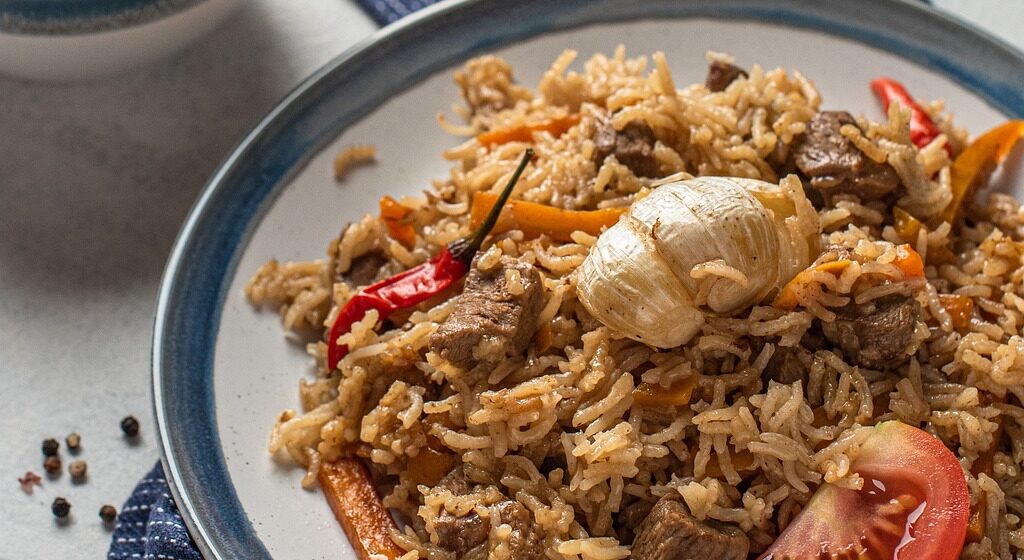Lamb pilaf, also known as pilau, is a hearty and flavourful rice dish that has been enjoyed for centuries in many parts of the world, particularly in Central and Western Asia. The dish’s rich history is deeply intertwined with the cultural and culinary traditions of these regions.
You can click here to jump to the recipe for lamb pilaf, or read on to find out more about this versatile dish.
What is Lamb Pilaf?
The name “plov” is related to “pilaf,” a name which English speakers are generally familiar with. However, while “pilaf” usually refers to a light, mostly-vegetable dish, plov is much more hearty. Alexander the Great (356 – 323 BC) is often credited with being the “inventor” of plov.
Although this recipe is based on lamb as a key ingredient, you can always substitute meat for something like chopped vege burgers or a meat-alternative to make a vegetarian option, vegans would have to substitute more ingredients, but it´s still possible, as is the case for most rice-based dishes.
The History of Lamb pilaf
Origins and Early Mentions
The earliest recorded recipes for pilaf date back to ancient Persia, now known as Iran. In the 10th century CE, the renowned Persian scholar Avicenna (Ibn Sina) included a section on pilaf in his medical encyclopaedia, Canon of Medicine. These early recipes emphasised the importance of using high-quality ingredients and achieving the perfect balance of flavours and textures.
Spread and Adaptation
From Persia, pilaf spread throughout the vast regions of Central and Western Asia, adapting to local ingredients and preferences. In the Middle East, lamb became a popular protein choice, while in India, pilaf dishes incorporated spices and aromatics like turmeric, cumin, and coriander.
Global Influence
Pilaf’s popularity extended beyond its original homeland, reaching Europe and eventually becoming a staple in many cuisines around the world. In Turkey, pilaf dishes like pilav and plov are ubiquitous, while in North Africa, variations like tagine and couscous have become culinary icons.
Key Characteristics and Ingredients
Lamb pilaf typically features fragrant rice cooked in a flavorful broth or oil, often with added vegetables, nuts, and spices. The dish is often topped with a crispy layer of rice known as tahdig.
Modern Adaptations
Today, lamb pilaf remains a versatile and beloved dish, with countless variations and adaptations. Chefs and home cooks continue to experiment with ingredients, techniques, and flavour profiles, creating new and exciting interpretations of this classic dish.
Cultural Significance
Lamb pilaf is more than just a meal; it is a cultural symbol that reflects the rich culinary heritage of many regions. From special occasions to everyday meals, pilaf continues to bring people together and nourish their bodies and souls.
Recipe for Lamb Pilaf or Lamb Plov
Ingredients
- 120g Prunes
- 1 tbsp Lemon Juice
- 2 tbsp Butter
- 1 Chopped Onion
- 450g Lamb
- 2 Cloves Garlic
- 600ml Vegetable Stock
- 2 Cups Rice
Directions
Place the raisins and prunes into a small bowl and pour over enough water to cover.
Add lemon juice and let soak for at least 1 hour.
Drain.
Roughly chop the prunes.
Meanwhile, heat the butter in a large pan, add the onion, and cook for 5 minutes.
Add cubed lamb, ground lamb, and crushed garlic cloves.
Fry for 5 minutes, stirring constantly until browned.
Pour 2/3 cup (150 millilitres) of stock into the pan.
Bring to a boil, then lower the heat, cover, and simmer for 1 hour, or until the lamb is tender.
Add the remaining stock and bring to a boil.
Add rinsed long-grain white rice and a large pinch of saffron.
Stir, then cover, and simmer for 15 minutes, or until the rice is tender.
Add the drained raisins, drained chopped prunes, and salt and pepper to taste.
Heat through for a few minutes, then turn out onto a warmed serving dish and garnish with sprigs of flat-leaf parsley.
Enjoy Your Food
The history of lamb pilaf is a testament to the power of food to transcend borders and connect people across cultures. This simple yet flavourful dish has stood the test of time, enduring through generations and adapting to new tastes and preferences. As long as there is rice and lamb, there will be pilaf, a dish that continues to bring warmth, comfort, and joy to countless tables around the world.
Give it a go, and let us know how you get on, and if you have any top tips to share, you can add a comment below.

Leave a Reply